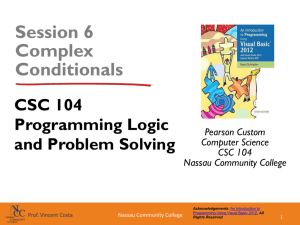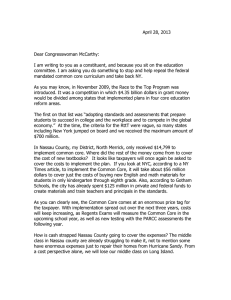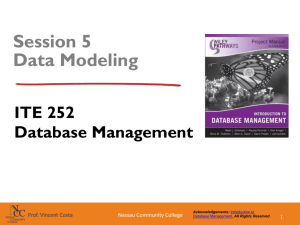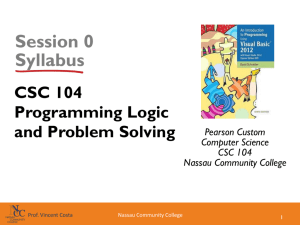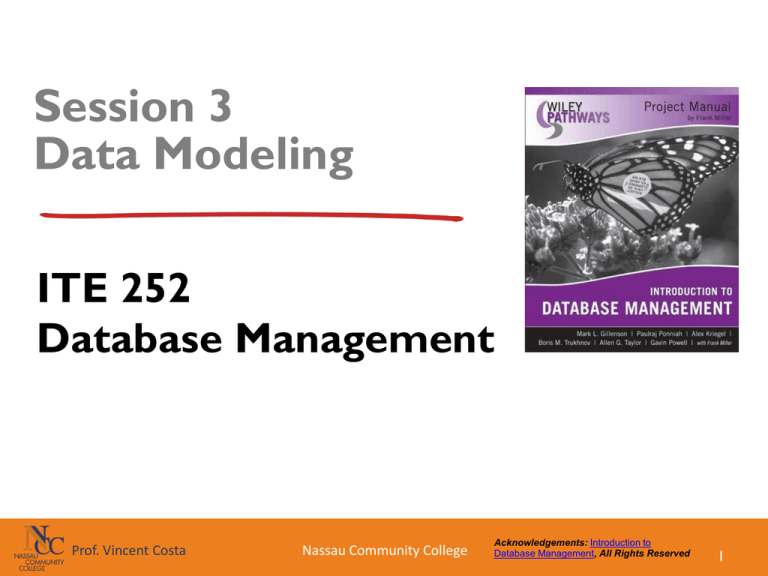
Session 3
Data Modeling
ITE 252 international, open membership, notfor-profit technology standards
Database
Management
consortium.
Prof. Vincent Costa
Nassau Community College
Acknowledgements: Introduction to
Database Management, All Rights Reserved
1
Database Design
• Three-part process:
– Conceptual design: Identify requirements of
stakeholders and data requirements
– Logical design: Identify type of database
application needed; data modeling (identifying
entities, attributes, relationships)
– Physical design: Implementation; physical
hardware design and platform; installation and
configuration of server and database creation
Prof. Vincent Costa
Nassau Community College
Acknowledgements: Introduction to
Database Management, All Rights Reserved
2
Database Design
Prof. Vincent Costa
Nassau Community College
Acknowledgements: Introduction to
Database Management, All Rights Reserved
3
Database Types
1. Transactional
Supports business transactions
• For example, sales, Online Transaction Processing
(OLTP)
international,
open membership,
not– Traditionally
a client/server
environment
for-profit technology standards
– Concerns:
Concurrency, throughput
consortium.
–
Prof. Vincent Costa
Nassau Community College
Acknowledgements: Introduction to
Database Management, All Rights Reserved
4
Database Types
2. Decision support system (DSS)
–
–
–
–
–
Supports business decisions
Types: Data warehouses, reporting databases, data marts
Primary goal: Data retrieval and evaluation
international, open membership, notBulk loading
used to add data
for-profit technology standards
Concerns:
Access speeds, throughput
consortium.
3. Hybrid
– Mixture of transactional and DSS types
Prof. Vincent Costa
Nassau Community College
Acknowledgements: Introduction to
Database Management, All Rights Reserved
5
Modeling Goals
• Design with understanding that:
– All applications written for database are dependent on
database structure
– If database is altered, applications may need to be altered
international, open membership, notor rewritten
for-profit technology standards
business
objectives
consortium.
• Support
• Simple, easy-to-read, easy-to-comprehend structure
• Scalability
Prof. Vincent Costa
Nassau Community College
Acknowledgements: Introduction to
Database Management, All Rights Reserved
6
Business Rules
• Business rules:
– Processes and flows used in organization’s daily work,
including:
• Organizational policies
• Calculations and formulas
• Rules and
regulations open membership, notinternational,
• Database systems
should support
business rules
for-profit technology
standards
consortium.
– Some rules
may be better enforced by database design
– Others may be better handled through database
application
Prof. Vincent Costa
Nassau Community College
Acknowledgements: Introduction to
Database Management, All Rights Reserved
7
Entity-Relationship (E-R) Modeling
• Entities:
– “Things” to track in database
• Physical objects (people or products)
• Conceptual entities (loan balances or interest rates)
international, open membership, notfor-profit technology standards
consortium.
Prof. Vincent Costa
Nassau Community College
Acknowledgements: Introduction to
Database Management, All Rights Reserved
8
Entity-Relationship (E-R) Modeling
• Attributes:
– Information tracked about entity
– Each entity has attributes
– For example:
open membership, not• Entity: international,
Employees
for-profit technology standards
• Attributes: Hire Date, Pay Rate, Social Security ID, Employee
consortium.
Number, Home Address
– One attribute used as unique identifier or primary key
Prof. Vincent Costa
Nassau Community College
Acknowledgements: Introduction to
Database Management, All Rights Reserved
9
Entity-Relationship (E-R) Modeling
• Relationships:
– When one entity references information from
another entity
– For example:
• Time Card entity must reference an Employee entity
– Time Card entity is referencing entity
– Employee entity is referenced entity
– Primary keys ensure referential integrity
Prof. Vincent Costa
Nassau Community College
Acknowledgements: Introduction to
Database Management, All Rights Reserved
10
Entity-Relationship (E-R) Modeling
Prof. Vincent Costa
Nassau Community College
Acknowledgements: Introduction to
Database Management, All Rights Reserved
11
Basic Database Objects
• Tables: Store unique instances of entity
– Columns (fields) represent attributes
– Rows (records) represent individual occurrences of
that entity
• Views:
– Customized representations of table information
Prof. Vincent Costa
Nassau Community College
Acknowledgements: Introduction to
Database Management, All Rights Reserved
12
Basic Database Objects
Prof. Vincent Costa
Nassau Community College
Acknowledgements: Introduction to
Database Management, All Rights Reserved
13
Basic Database Objects
• Index:
– Organizes and sorts data
– Provides pointer to specific physical location of
data on storage media
– May be:
• Primary or secondary
• Clustered or nonclustered
– Balanced-tree index (b-tree, or binary tree index):
• Most common type of index in modern databases
Prof. Vincent Costa
Nassau Community College
Acknowledgements: Introduction to
Database Management, All Rights Reserved
14
B-Tree Index
Prof. Vincent Costa
Nassau Community College
Acknowledgements: Introduction to
Database Management, All Rights Reserved
15
Homework
• Read Chapter Two, pp.24-54
• Look Over Chapter Three, pp. 60-79
international, open membership, notfor-profit technology standards
consortium.
Prof. Vincent Costa
Nassau Community College
Acknowledgements: Introduction to
Database Management, All Rights Reserved
16


